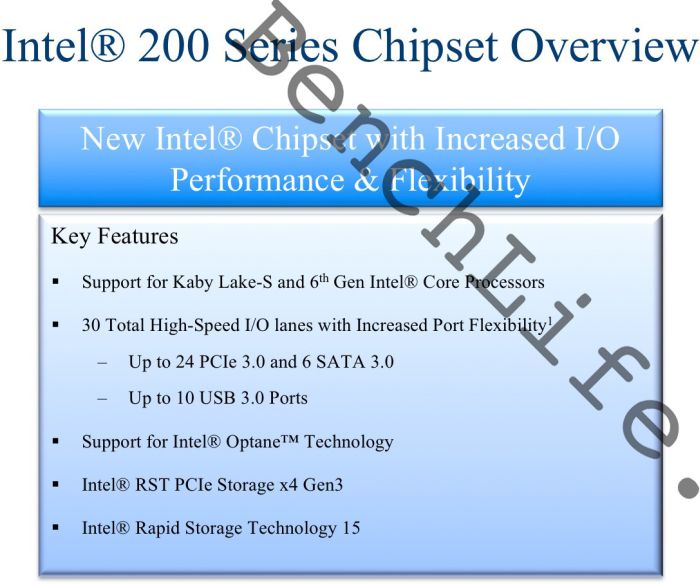OOPS! You forgot to upload swfobject.js ! You must upload this file for your form to work.
Processors Kaby Lake will coexist with Intel chipsets two hundredth series
![]()
|
xtreview is your : Video card - cpu - memory - Hard drive - power supply unit source |
|
|||
|
|
||||
 Recommended : Free unlimited image hosting with image editor
Recommended : Free unlimited image hosting with image editor
|
xtreview is your : Video card - cpu - memory - Hard drive - power supply unit source |
|
|
|
|
||
|
Xtreview Support  N-Post:xxxx Xtreview Support        |
PROCESSORS KABY LAKE WILL COEXIST WITH INTEL CHIPSETS TWO HUNDREDTH SERIES |
| Please Feel Free to write any Comment; Thanks  |
Kaby Lake and GeForce GTX 1080 Ti update the absolute world record 3DMark2001 SE (2017-08-10)
GeForce GTX 1080 Ti and Kaby Lake-X have distinguished themselves in Unigine Heaven Xtreme (2017-08-01)
Kaby Lake-X and GeForce GTX 1080 Ti have updated the world record 3DMark03 (2017-07-21)
Naked Crystal Kaby Lake-X entrenched at the top of the 3DMark06 rating (2017-07-16)
In the production of Monero, AMD Ryzen 5 processors outperform Intel Kaby Lake (2017-06-27)
Defect of Skylake and Kaby Lake processors can cause instability of system with Hyper-Threading activity (2017-06-26)
Intel talks about the ability of Kaby Lake-X to overclock to 5 GHz (2017-06-19)
Kaby Lake-X at 7.0 GHz allowed the Australians to update the record Unigine Heaven Xtreme (2017-06-14)
In late June, a tool will appear to remove the covers from Skylake-X and Kaby Lake-X (2017-06-13)
Processors Skylake-X and Kaby Lake-X registered in Intel price list (2017-06-09)
Preliminary data on the cost of Intel Skylake-X and Kaby Lake-X processors (2017-05-30)
Direct contact of the tank with the crystal processor allowed Kaby Lake to update a couple of records (2017-05-05)
Intel temperature jumps are not a sign of Kaby Lake processors failure (2017-05-05)
After the release of AMD Ryzen 5 in Japan Intel Kaby Lake processors are cheaper (2017-04-27)
Core i7-7740K Kaby Lake-X processor in the LGA 2066 version (2017-04-25)
Processors Coffee Lake and Kaby Lake will be able to work in some motherboards (2017-04-25)
Owners of Ryzen and Kaby Lake have lost the ability to receive updates on Windows 7 (2017-04-16)
Surface Pro 5 will receive Intel Kaby Lake processor (2017-04-09)
Intel Kaby Lake-G processors with integrated AMD graphics (2017-04-04)
Processors Pentium and Celeron generation Kaby Lake do not support Intel Optane (2017-04-02)
![]()
To figure out your best laptops .Welcome to XTreview.com. Here u can find a complete computer hardware guide and laptop rating .More than 500 reviews of modern PC to understand the basic architecture


7600gt review
7600gt is the middle card range.
We already benchmarked this video card and found that ...

 geforce 8800gtx and 8800gts
geforce 8800gtx and 8800gts  Xtreview software download Section
Xtreview software download Section  AMD TURION 64 X2 REVIEW
AMD TURION 64 X2 REVIEW  INTEL PENTIUM D 920 , INTEL PENTIUM D 930
INTEL PENTIUM D 920 , INTEL PENTIUM D 930  6800XT REVIEW
6800XT REVIEW  computer hardware REVIEW
computer hardware REVIEW  INTEL CONROE CORE DUO 2 REVIEW VS AMD AM2
INTEL CONROE CORE DUO 2 REVIEW VS AMD AM2  INTEL PENTIUM D 805 INTEL D805
INTEL PENTIUM D 805 INTEL D805  Free desktop wallpaper
Free desktop wallpaper  online fighting game
online fighting game  Xtreview price comparison center
Xtreview price comparison center Lastest 15 Reviews


Rss Feeds
Last News
- The new version of GPU-Z finally kills the belief in the miracle of Vega transformation
- The motherboard manufacturer confirms the characteristics of the processors Coffee Lake
- We are looking for copper coolers on NVIDIA Volta computing accelerators
- Unofficially about Intels plans to release 300-series chipset
- The Japanese representation of AMD offered monetary compensation to the first buyers of Ryzen Threadripper
- This year will not be released more than 45 million motherboards
- TSMC denies the presentation of charges from the antimonopoly authorities
- Radeon RX Vega 64 at frequencies 1802-1000 MHz updated the record GPUPI 1B
- AMD itself would like to believe that mobile processors Ryzen have already been released
- AMD Vega 20 will find application in accelerating computations
- Pre-orders for new iPhone start next week
- Radeon RX Vega 57, 58 and 59: the wonders of transformation
- ASML starts commercial delivery of EUV-scanners
- The older Skylake processors with a free multiplier are removed from production
- Meizu will release Android-smartphone based on Helio P40
- AMD Bristol Ridge processors are also available in American retail
- The fate of Toshiba Memory can be solved to the next environment
- duo GeForce GTX 1080 Ti in GPUPI 1B at frequencies of 2480-10320 MHz
- New Kentsfield overclocking record up to 5204 MHz
- Lenovo released Android-smartphone K8

HALO 3 HALO 3 - Final Fight!

PREY Prey is something you don t often see anymore: a totally unigue shooter experience.

computer news computer parts review Old Forum Downloads New Forum Login Join Articles terms Hardware blog Sitemap Get Freebies




